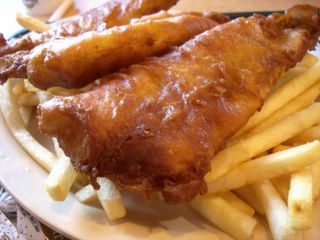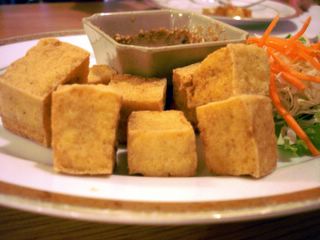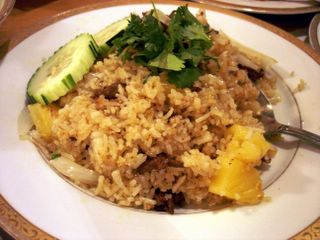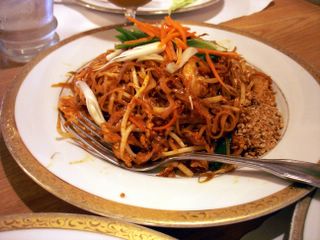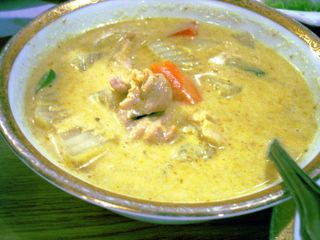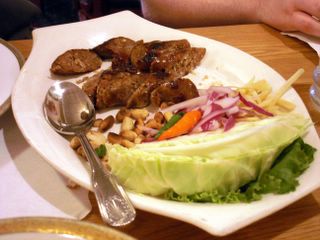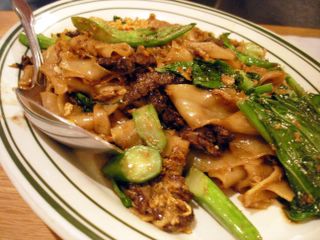Mitsuwa Marketplace - Costa Mesa

Like Japanese art, and the haiku poem, Japanese cuisine finds elegance thorugh simplicity. Watch fine artists like Shibutani of Sushi Shibucho in Costa Mesa and you will see economy and precision of movement as he builds masterpieces on the plate. Like a calligrapher's brush strokes, his sushi is bound by tradition yet animated by creativity.
Go to a traditional izakaya like Honda-Ya, or even a modern Japanese bistro like Cafe Hiro, and you'll find the same reverence to this philosophy on varying levels.
But when I can't find the time or money to eat at these favorites of mine, there's Mitsuwa Marketplace. Located near the rear of the store, Mitsuwa offers a long refrigerated case of bento boxes.
"Bento" is the Japanese version of "fast-food". And it's got all the essentials for a busy Japanese office drone. Rice, meat and vegetables; all arranged artfully in compartments and packed conveniently in a sealed plastic box.
A quick and balanced meal that doesn't skimp on quality ingredients, bento is the essense of Japanese cuisine in a ready-to-go container.
My favorite has to be the chicken karaage bento ($4.99). Golden, crispy chunks of fried chicken that has been marinated in sake and soy accompany white rice and all sorts of different vegetable nibbles.
The bento I chose included crisp tender green beans glazed in shoyu and sesame seeds and in a separate compartment, a tuft of wiggly black strands that I can only guess is a seaweed of some sort. And with all bentos there's a steamed broccoli floret, some marinated lotus root, and a requisite block of tamago to cleanse the palate after you finish the meal.

And if you're hankering for a bento sampler, Mitsuwa also has a box ($4.50) that has a combination of items playing the role of protein. One I tried recently had a breaded fillet of white fish, under which lurked a fried gyoza, a potato croquette, a shumai, a barbecue sauce laden chunk of fish cake, and a morsel of their chicken karaage. All this is served with varying accompaniments and, of course, rice.

For an even quicker bite, I get onigiri ($1.00), which are rice triangles with a little bit of filling stuffed inside, all wrapped in nori (seaweed). The nori is wrapped in plastic against the rice so that it remains crisp.
You have to follow the numbered and diagramed instructions on how to unsheath the seaweed prior to eating. Do it wrong and you get a mess of rice grains and ripped seaweed. Do it right and you get the crunch and slightly fishy nori neatly wrapped around the shaped rice.
The filling in the middle of the rice triangle, whether it is salmon, tarako (cod roe), or tuna, serves as a flavoring, so don't expect a lot of it.
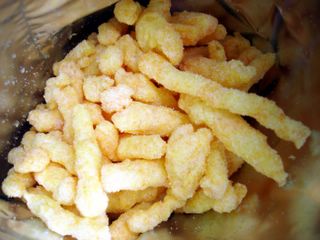
While the bentos and onigiris nod to Japanese tradition, Mitsuwa also has other products that flies in the face of it. If someone is looking for evidence to rally against globalization, take these curly, dense cheesy snacks being sold at Mitsuwa. Recognize them yet?
Yep. Chester Cheetah has slinked his way into the Land of the Rising Sun. Now the Japanese have their chance at obesity and slovenness too!
This version of the dastardly Cheeto is sweeter and less sharp-tasting that its stateside counterpart. They are also lighter in color and come in a bag that seems to be half the size of a regular Cheetos bag.
I say, get it over with and package it in a Costco-sized feed-bag for gosh sakes! That's the American Way!
And I'm not quite sure what the oozy mayo-like substance pictured near the bottom of the bag is, but I assume it's supposed to be melted cheese. Although when I first picked up the bag, I secretly wished it *WAS* mayo.
Think of it, "mayo flavored Cheetos"! What a decadent and unholy alliance that would be!

Nevertheless, I doubt you'd be surprised if I told you that I couldn't stop eating these until I was sure the bag was emptied of crumbs and my fingers were caked with powdered cheese dust. The Japanese better be careful or there might be a deep fried twinkie in their future!
As good as I think this junk food is, I thank goodness that Japanese cuisine still has some traditionalist hold outs to bring its food culture back in line.
Mitsuwa Marketplace
(714) 557-6699
665 Paularino Ave
Costa Mesa, CA 92626




